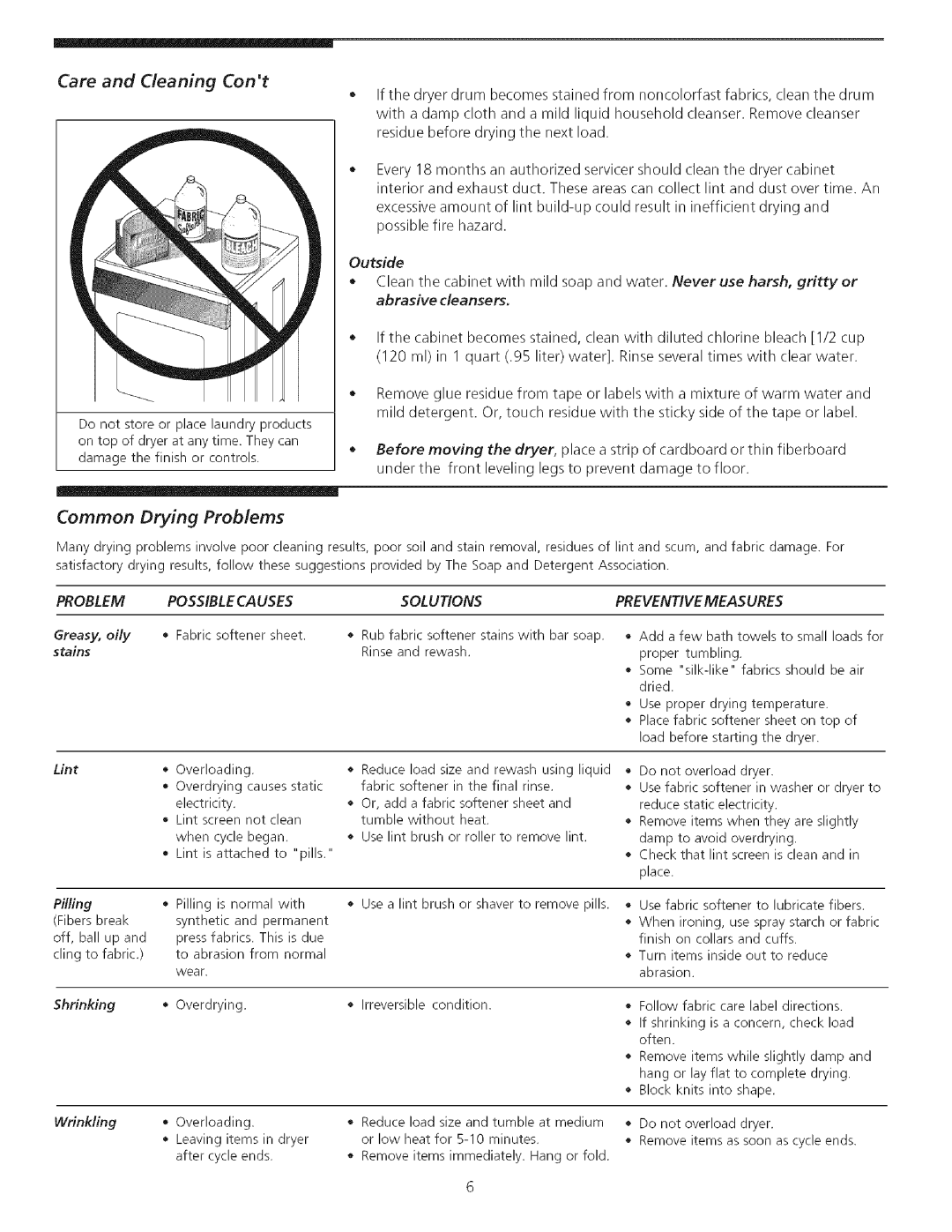
Care and Cleaning Con't
If the dryer drum becomes stained from noncolorfast fabrics, clean the drum
with a damp cloth and a mild liquid household cleanser. Remove cleanser residue before drying the next load.
Every 18 months an authorized servicer should clean the dryer cabinet interior and exhaust duct. These areas can collect lint and dust over time. An
excessive amount of lint
possible fire hazard.
Outside
Clean the cabinet with mild soap and water. Never use harsh, gritty or abrasive cleansers.
Do not store or place laundry products on top of dryer at any time. They can damage the finish or controls.
If the cabinet becomes stained, clean with diluted chlorine bleach [I/2 cup (120 ml) in 1 quart (.95 liter) water]. Rinse several times with clear water.
Remove glue residue from tape or labels with a mixture of warm water and mild detergent. Or, touch residue with the sticky side of the tape or label.
Before moving the dryer, place a strip of cardboard or thin fiberboard
under the front leveling legs to prevent damage to floor.
Common Drying Problems
Many drying problems involve poor cleaning results, poor soil and stain removal, residues of lint and scum, and fabric damage. For satisfactory drying results, follow these suggestions provided by The Soap and Detergent Association.
PROBLEM | POSSIBLECAUSES | SOLUTIONS | PREVENTIVEMEASURES |
Greasy, oily | e Fabric softener sheet. | o Rub fabric | softener stains with bar soap. |
stains |
| Rinse and | rewash. |
Lint | Overloading. | o Reduce | load size | and | rewash | using liquid | ||
• | Overdrying causes static | fabric softener | in | the | final | rinse, | ||
| electricity. | Or, add | a fabric softener | sheet | and | |||
e | Lint screen not clean | tumble | without | heat. |
|
|
| |
| when cycle began. | Use lint | brush | or | roller | to | remove lint. | |
| Lint is attached to "pills." |
|
|
|
|
|
|
|
o Add a few bath towels to small loads for
proper tumbling.
o Some
o Use proper drying temperature. Place fabric softener sheet on top of load before starting the dryer.
Do not overload dryer.
oUse fabric softener in washer or dryer to
reduce static electricity.
oRemove items when they are slightly
damp to avoid overdrying.
oCheck that lint screen is clean and in place.
Pilling (Fibers break
off, ball up and cling to fabric.)
Shrinking
Pilling is normal with synthetic and permanent
press fabrics. This is due to abrasion from normal
wear.
Overdrying.
o Use a lint brush or shaver to remove pills.
Irreversible condition.
Use fabric softener to lubricate fibers.
o When ironing, use spray starch or fabric finish on collars and cuffs.
Turn items inside out to reduce
abrasion.
o Follow fabric care label directions.
o If shrinking is a concern, check load often.
Remove items while slightly damp and hang or lay flat to complete drying. Block knits into shape.
Wrinkling | • | Overloading. | Reduce | load size and tumble | at medium | o | Do not | overload | dryer. |
| • | Leaving items in dryer | or low | heat for |
| o | Remove | items | as soon as cycle ends. |
|
| after cycle ends. | o Remove | items immediately. | Hang or fold. |
|
|
|
|
